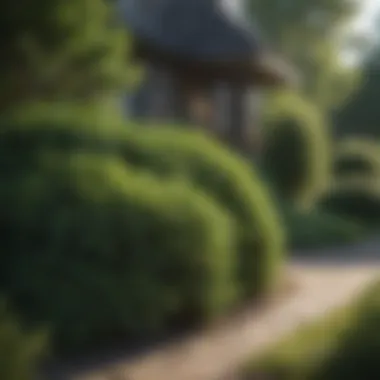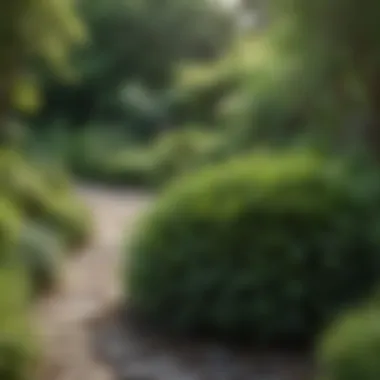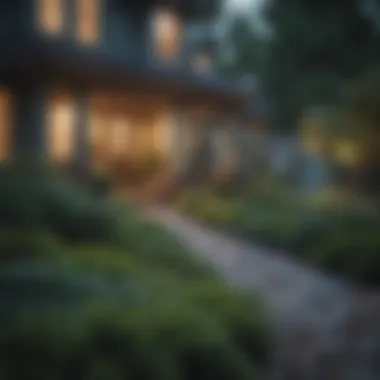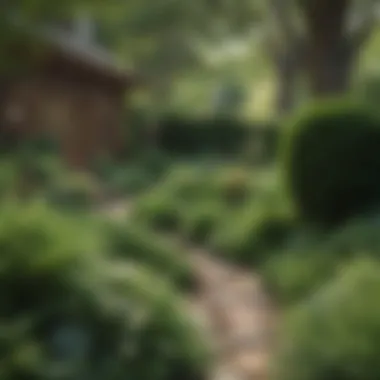Evergreen Plants for Front Yard: A Comprehensive Guide


Intro
Evergreen plants hold a significant place in landscape design. Their ability to maintain foliage year-round provides visual interest and stability to the front yard. Homeowners and gardening enthusiasts are increasingly recognizing the value these plants bring, not just in aesthetics but also in ecological benefits. This guide aims to illuminate the variety of choices available, their care requirements, and how to effectively integrate them into landscaping plans. By exploring the characteristics and advantages of evergreen plants, readers can make informed decisions that enhance the beauty and sustainability of their outdoor spaces.
Key Insights and Trends
In recent years, the preference for sustainable gardening practices has grown among homeowners. This trend encourages the selection of plants that provide long-term benefits while minimizing environmental impact. Evergreens fit perfectly into this framework due to their hardy nature and low maintenance needs.
Current trends in landscaping
- Native species: Many gardening enthusiasts are gravitating towards native evergreen species. These plants not only thrive in their natural environment but also support local wildlife.
- Mixed plantings: Combining evergreens with seasonal flowers and shrubs creates dynamic visual layers.
- Low maintenance landscapes: Homeowners seek plants that require less water and upkeep. Evergreens often fit this criterion well, as they tolerate drought once established.
Popular gardening techniques of the season
- Mulching: This technique enhances soil moisture and suppresses weeds, making it easier to maintain evergreen plants.
- Vertical gardening: Maximizing space by planting vertically is gaining attention. Evergreen climbers can be a perfect addition to this approach.
Practical Tips and How-To Guides
Implementing evergreen plants effectively in a front yard requires some strategic planning. Below are practical tips for choosing and maintaining these plants in your outdoor space.
Step-by-step guide for planting evergreens
- Choose the right variety: Assess your climate and soil type to select appropriate evergreen species.
- Plan the layout: Consider the space and light conditions. Taller evergreens can be positioned at the back, with shorter varieties in front for visual depth.
- Prepare the soil: Make sure the soil is well-draining. Amend with compost to enrich the soil.
- Planting: Dig holes for each plant that are twice as wide as the root ball. Position the plant, backfill with soil, and water thoroughly.
- Mulch: Apply mulch around the base to retain moisture and suppress weeds.
Care techniques for healthy evergreens
- Watering: During hot months, ensure your evergreens get sufficient water, especially in their first year of growth.
- Pruning: Regular trimming helps maintain shape and encourage new growth.
- Fertilizing: Use a balanced fertilizer once a year to promote healthy development.
"Incorporating evergreen plants transforms your front yard into a vibrant, ever-changing space throughout the seasons."
By following the insights and practical tips discussed, homeowners can harness the advantages of evergreen plants to achieve a lush and sustainable landscape in their front yards.
Prelude to Evergreen Plants
Evergreen plants serve as a crucial component in garden design. They provide structure and continuity throughout the seasons. While many plants may bloom and flourish during specific times of the year, evergreens maintain their foliage year-round. This characteristic makes them particularly valuable for homeowners seeking to enhance curb appeal and landscaping aesthetics.
Definition of Evergreen Plants
The term "evergreen" refers to plants that retain their leaves throughout the year. Unlike deciduous plants, which shed their foliage seasonally, evergreens conserve their leaves in various forms. This group includes trees, shrubs, and ground covers. Common examples are pine, spruce, and holly. These plants can thrive in numerous environments, showcasing a variety of colors, textures, and forms. They can adapt to different climates, making them versatile choices for landscaping.
Importance in Landscaping
Incorporating evergreen plants into landscaping designs provides multiple benefits. One of the key advantages is the year-round visual interest they create. When gardens lack perennial blooms, evergreens provide stability and color changing occasionally through seasons. Additionally, these plants offer habitat and food for wildlife. This encourages biodiversity in your garden.
The presence of evergreens also assists in framing other plant varieties. They help establish a background for seasonal flowers and shrubs, enhancing their prominence. Many landscape designers favor them for this very reason. Careful placement of evergreens can lead to a balanced and cohesive garden layout.
Moreover, evergreens contribute to environmental sustainability. They play a role in reducing soil erosion and improving air quality. Their root systems stabilize soil, and they absorb carbon dioxide, which benefits the overall ecosystem.
In summary, understanding evergreen plants is vital for homeowners and gardening enthusiasts. Their unique properties and benefits allow for dynamic and ecologically sound landscaping options.
Benefits of Using Evergreen Plants in Front Yards
Utilizing evergreen plants in front yards goes beyond simply choosing attractive greenery. This choice impacts the overall landscape, aesthetic, and even the ecological dynamics of the space. The benefits of these plants can enhance the appeal of a home and contribute positively to the local environment. Below, we delve deeper into three key aspects that illustrate why evergreen plants are a smart choice for front yards: aesthetic appeal, environmental advantages, and low maintenance requirements.
Year-Round Aesthetic Appeal
Evergreen plants retain their foliage throughout the year, providing an enduring visual structure. Unlike deciduous plants that lose their leaves in winter, evergreens offer consistency to the landscape. Their presence adds depth and texture, which can complement seasonal color changes.


- Variety of Colors and Shapes: The diversity among evergreen species allows for a rich palette of greens, blues, and even variegated forms. From the tall and narrow Italian Cypress to the bushy Boxwood, options abound to create a visually engaging front yard.
- Foundation for Seasonal Displays: These plants serve as a perfect backdrop for seasonal flowers and decorations. They stabilize the landscape's style, which can be particularly important during festive seasons when homeowners often wish to enhance their front yards. With evergreens, the beauty persists all year, offering frames that highlight other plants and decorations.
Environmental Advantages
Incorporating evergreen plants in front yards provides several ecological benefits. Their year-round foliage plays a crucial role in various environmental aspects, particularly regarding air quality and wildlife support.
- Air Quality Improvement: Evergreen trees and shrubs naturally filter pollutants from the air. Their leaves capture dust, pollen, and other particulates, leading to cleaner and healthier air around properties.
- Habitat for Wildlife: These plants are not just attractive; they also provide shelter and food for birds, insects, and other wildlife. For instance, Eastern Red Cedar berries can attract birds while providing them with essential habitat throughout the seasons. The evergreen foliage also offers protection during extreme weather events.
"Evergreens convert carbon dioxide into oxygen all year long, making them crucial for maintaining air quality."
Low Maintenance Requirements
One of the most significant attractions of evergreen plants is their generally low maintenance nature. They require less care than many other plants, making them suitable for various homeowners.
- Minimal Pruning Needs: Most evergreen species require less frequent trimming. Unlike flowering plants that may need deadheading or intensive pruning to encourage blooms, evergreens maintain their form with occasional shaping.
- Drought Resistance: Many evergreen plants exhibit drought-resistant properties once established. For example, Blue Spruce thrives in a range of conditions and can survive during dry spells, reducing the need for constant watering.
- Fertilization: Evergreens typically need less fertilization compared to other plant varieties. Natural weather conditions often provide adequate nutrients. Simple annual checks can ensure they thrive without excessive effort from homeowners.
In summary, selecting evergreen plants for front yards provides numerous benefits, from aesthetic consistency and environmental contributions to their low-maintenance nature. These aspects make evergreens a wise addition to any landscape.
Selecting the Right Evergreen Plants for Your Front Yard
Choosing the right evergreen plants for your front yard is a crucial step in achieving a well-designed landscape. The selection process should consider various factors that affect not only aesthetics but also the health of the plants and the overall functionality of your yard. Evergreen plants serve as a functional and attractive element, providing structure, color, and year-round interest. With so many options available, thoughtful selection can greatly enhance your front yard's appeal and sustainability.
Climate Considerations
When selecting evergreen plants, it is essential to assess the climate in your region. Different plants thrive in different weather conditions. For instance, some evergreens prefer cooler climates, while others can tolerate heat and humidity. Understanding your local climate helps you choose suitable plants that can withstand seasonal changes without stress. It's helpful to check the USDA Plant Hardiness Zones, which provide specific guidelines about plant viability based on temperature extremes.
Factors to consider include:
- Temperature fluctuations: Choose plants that can endure your area's seasonal shifts.
- Humidity levels: Some plants may require a specific moisture range.
- Light exposure: Evaluate how much sunlight your front yard receives daily.
Soil Quality and Drainage
Soil quality is another fundamental aspect that greatly influences plant health. Good soil provides essential nutrients, retains moisture, and supports proper drainage. Before planting, you should analyze your soil type. Is it sandy, clayey, or loamy? Each type has its benefits and drawbacks.
Proper drainage needs to be ensured, as waterlogged soil can damage root systems and lead to diseases. When selecting evergreens, consider the following:
- Amendments: Based on your soil type, you might need to amend it with organic matter for improved structure and nutrients.
- pH levels: Certain evergreens thrive better in specific pH ranges. You might want to perform a soil test to find out.
- Mulching: Applying mulch around the plants can help retain soil moisture and improve drainage over time.
Space and Growth Patterns
Understanding the growth patterns of selected evergreen plants is vital to ensure they fit well within the space you have. Before planting, consider the potential size of the plants at maturity. Overcrowding can lead to competition for resources and can impede the growth of your plants.
Key points to consider:
- Mature size: Research how tall and wide each species grows. This will help you maintain suitable spacing.
- Growth rate: Some evergreens grow faster than others. Knowing growth rates aids in planning how quickly you will achieve your desired look.
- Design layout: Consider how different growth habits can complement each other, such as placing taller plants behind shorter ones to create depth.
By carefully considering climate, soil quality, and space, you will be better equipped to select the right evergreen plants. This due diligence will promote healthier plants and a more cohesive landscape design.
Popular Evergreen Plants for Front Yards
Choosing the right evergreen plants for your front yard is crucial. They not only enhance the aesthetic of your space but also provide various practical benefits. Evergreen plants, characterized by their ability to retain foliage throughout the year, offer visual interest in all seasons. This section will explore popular categories of evergreen plants and their characteristics.
Conifers
Types of Conifers
Conifers represent a diverse group of evergreen trees and shrubs, known for their needle-like leaves. They can be conical, globular, or sprawling in shape. Some well-known types include Pine, Spruce, and Cedar. Each type has its unique adaptation and visual appeal. Conifers are often favored because they are hardy and can thrive in various climates. For instance, the Eastern White Pine grows tall and straight, providing a classic look.
Another popular option is the Blue Spruce, admired for its striking bluish-grey foliage. This added color can contrast elegantly with other plants in your yard. Furthermore, conifers are usually low maintenance, requiring few interventions once established. Their fast growing nature can quickly enhance your landscape's character.


Growth Characteristics
The growth characteristics of conifers vary widely. Some species, like Giant Sequoia, can grow immensely tall, whereas others, like Dwarf Alberta Spruce, remain compact. This diversity allows homeowners to choose conifers based on space and design factors. Generally, conifers grow steadily, making them suitable for permanent landscape features.
Their ability to persist through harsh weather conditions adds to their appeal. However, it's worth noting that some conifers may require specific soil conditions to thrive. Understanding these growth patterns will aid in selecting the right plants for your front yard.
Shrubs
Varieties of Evergreen Shrubs
Evergreen shrubs offer versatility and a knack for providing structure to landscapes. Varieties such as Boxwood, Holly, and Juniper are favorites among gardeners. Boxwood, with its rounded shape, lends elegance to gardens, while Holly provides bright berries in winter. These shrubs can create beautiful borders or stand alone as focal points.
Their ability to adapt to diverse growing conditions is a significant advantage. They can thrive in partial shade or full sun. However, selecting the right shrub requires consideration of its mature size. While these shrubs can enhance the landscape, they require adequate space for their growth patterns.
Usage in Landscaping
Evergreen shrubs are often used to create privacy screens or formal hedges. They serve not only aesthetic purposes but also functional ones, such as noise reduction. By strategically placing shrubs, homeowners can delineate spaces or increase security. Their year-round foliage provides structure in winter, making them an excellent choice for any season.
When paired with flowering plants, evergreen shrubs can create striking contrasts. Consider the combination of Juniper and a colorful flowering plant to enhance the landscape. However, mindful placement is key. Some shrubs can grow large quite fast, and understanding their growth habit is necessary to maintain balance.
Ground Covers
Benefits of Ground Covers
Ground covers are vital in landscape design, serving various purposes. They reduce soil erosion, suppress weeds, and provide a dense carpet of greenery. Popular ground covers like Creeping Thyme and English Ivy continue to thrive through changing seasons. Without proper management, however, some species can become invasive, overtaking desired areas. Choosing the right ground cover still rewards gardens with a lush look.
Additionally, these plants require less maintenance than traditional lawns. They help retain moisture and require minimal mowing or reseeding.
Recommended Species
A variety of species can be used as effective ground covers. Creeping Juniper is particularly well-liked for its hardiness and adaptability. Its sprawling nature makes it an excellent choice for poor soil and rocky areas. Other noteworthy species include Allegheny Spurge, which offers blooms in spring and attractive foliage year-round.
The right choice of ground covers can enhance your landscape significantly. It contributes not only to beauty but also to ecological balance by providing habitat for small wildlife.
In summary, selecting popular evergreen plants for front yards involves understanding their types, growth characteristics, and landscape uses. Integrating conifers, shrubs, and ground covers effectively can transform outdoor spaces. The key is to match plants to the specific conditions and requirements of your yard.
Designing a Cohesive Landscape with Evergreens
Creating a cohesive landscape with evergreen plants is essential for achieving a well-balanced, visually appealing outdoor space. This approach not only enhances the aesthetic quality of your front yard but also provides a structured framework throughout the year. Evergreens offer consistency. They remain green in all seasons, providing a backdrop that allows other plants to shine. It is important to consider different layers in your landscape design to optimize space and visual impact.
A cohesive landscape helps in achieving harmony and flow between various elements of your garden. Gradually transitioning between heights and shapes creates a natural progression that draws the eye across the space. Additionally, a well-planned landscape can also help with climate adaptation, offering shelter and microclimates for more delicate plants around them.
Creating Layers with Evergreen Plants
One significant aspect of landscape design is layering. Using evergreen plants to create layers can achieve depth and dimension in your yard. They can be classified into three main layers: tall, mid-height, and low-growing plants. Tall evergreens can serve as a backdrop, offering height, while mid-height plants can fill in visible gaps. Finally, low-growing ground covers can add texture and color, provide cover for the soil, and suppress weeds.
When selecting plants for each layer, consider their growth habits and visual qualities. For tall plants, options such as arborvitae and blue spruce provide height and structure. Mid-height selections might include boxwood or holly, and low-growing ground covers may involve creeping juniper or wintergreen.
Complementary Plant Varieties
The integration of complementary plant varieties can elevate the landscaping experience. Choosing plants that enhance the evergreen plants’ beauty and texture creates an engaging visual narrative. Consider pairing evergreens with various flowering shrubs or ornamental grasses. The contrast between the evergreen's solid color and the vibrant blossoms of flowering plants can generate interest and focal points in the landscape.
Additionally, seasonal considerations can guide your selections. For instance, combining rhododendrons or azaleas with evergreen plants offers blooms in spring, contrasting the evergreen's stable structure. The goal is to create dynamic interactions between the plants while maintaining the evergreen backdrop.
"An ideal landscape design utilizes the natural characteristics of plants to create a unified and harmonious outdoor environment."
For more insights on plant selection and landscape strategies, visit Wikipedia or Britannica.
Care and Maintenance of Evergreen Plants


Successfully maintaining evergreen plants requires a deliberate approach. These plants, valued for their year-round foliage, still need attention to thrive. Understanding specific care routines will ensure that they remain lush and robust in your front yard. Healthy plants contribute to the overall beauty of your landscape while enhancing its ecological benefits. Watering, fertilization, pruning, and pest and disease management are four essential components that significantly affect the health and longevity of your evergreens.
Watering Needs
Watering is crucial for the establishment and continued health of evergreen plants. Newly planted evergreens need consistent moisture to develop strong root systems. However, overwatering can lead to root rot, which is detrimental. Here are some key points regarding watering:
- Soil Moisture: Always check the soil moisture before watering. You should bury your finger about an inch into the soil. If it feels dry, water your plants.
- Frequency: During the growing season, evergreen plants typically require watering every one to two weeks.
- Deep Watering: When watering, a deep soak is more beneficial than frequent shallow watering. This encourages deep root growh.
Fertilization Practices
Fertilizing evergreen plants is important for their growth and vibrancy. The right nutrients promote strong foliage and help plants resist stress. Consider the following aspects:
- Type of Fertilizer: Use slow-release or organic fertilizers to provide nutrients gradually. Look for high nitrogen and potassium content.
- Timing: Fertilize in early spring just before the growing season begins. This timing allows plants to utilize nutrients effectively.
- Application Rate: Follow the recommended rates on the fertilizer package. Over-fertilizing can jeopardize plant health.
Pruning Techniques
Pruning is essential for maintaining the shape and health of evergreen plants. It removes dead or diseased branches, encourages new growth, and improves air circulation. Understanding proper techniques will yield better results:
- Timing: Late winter or early spring is the best time to prune evergreens before new growth starts.
- Tools Needed: Use clean, sharp tools to make precise cuts. This minimizes damage to the plant.
- Cutting Method: Make cuts just above a bud or branching point to encourage a healthy structure.
Pest and Disease Management
Pests and diseases can threaten the vitality of evergreen plants. Proactive management strategies are vital to protect your landscape. Focus on the following approaches:
- Regular Inspection: Make a habit of inspecting your plants regularly for signs of pests or diseases.
- Integrated Pest Management (IPM): Utilize a mixed approach that combines biological, cultural, and chemical methods for pest control, ensuring minimal harm to beneficial organisms.
- Timely Action: Respond quickly to any infestations or diseases. Early detection often leads to more effective treatment.
Establishing a solid care routine can significantly reduce the chances of diseases and pests, ensuring your evergreen plants remain healthy.
Sustainable Practices for Evergreen Gardening
In the context of evergreens and landscaping, sustainable practices have emerged as essential considerations for homeowners and gardening enthusiasts. These practices aim to create an ecological balance, reducing the environmental footprint while enhancing aesthetics. When choosing evergreen plants, considering sustainability means not just selecting beautiful options, but also ensuring they contribute positively to the ecosystem. Integrated sustainable practices play an important role in maintaining healthy landscapes, preventing soil erosion, and conserving water. Incorporating these principles fosters an environment that thrives for years.
Eco-Friendly Landscaping Approaches
Eco-friendly landscaping approaches prioritize the use of natural resources in a way that promotes sustainability. This can include a variety of techniques:
- Permaculture Design: This method emphasizes working with nature rather than against it. It encourages planting evergreens that are native to the area, which often require less water and maintenance.
- Water Conservation: Rain gardens or bioswales may be incorporated to manage rainfall effectively. Utilizing drip irrigation systems also conserves water by delivering it directly to the root zone.
- Organic Materials: Utilizing compost and organic fertilizers boosts soil health. Organic mulch helps to retain soil moisture while suppressing weeds.
These strategies do not only support the environment but can also lower ongoing maintenance costs for homeowners.
Utilizing Native Species
Planting native evergreen species is an effective sustainable practice in landscaping. Native plants are adapted to local conditions, making them inherently more resilient. They often require little irrigation, reducing water usage significantly. Moreover, native evergreens can provide habitat and food for local wildlife, contributing to biodiversity. Here are some considerations:
- Adaptability: These plants thrive in the local climate, minimizing the need for fertilizers or pesticides.
- Ecosystem Support: Native species play a crucial role in local ecosystems. They help maintain soil health and provide shelter and food for various species.
- Aesthetic Value: Native evergreens possess unique characteristics that reflect the local landscape, adding natural beauty to the yard.
Utilizing these native plants often results in a robust front yard that enhances ecological stability while ensuring a year-round attractive landscape.
Incorporating sustainable practices in evergreen gardening not only beautifies your space but also nurtures the environment for future generations.
Closure and Final Thoughts
The significance of incorporating evergreen plants in front yard landscaping cannot be overstated. These plants offer lasting beauty, structural integrity, and ecological benefits throughout the year. In areas where seasonal changes drastically alter the environment, evergreens serve as constant elements that maintain visual interest. This article has covered various angles regarding the selection and maintenance of evergreen plants in a front yard setting, emphasizing their versatility and adaptability.
Recap on Evergreen Plant Benefits
Evergreen plants bring numerous advantages to front yards. Here are a few key points to remember:
- Year-Round Aesthetic Appeal: Unlike deciduous plants that shed their leaves seasonally, evergreens maintain their foliage, providing greenery regardless of the time of year.
- Environmental Benefits: These plants contribute to improved air quality and provide habitats for local wildlife.
- Low Maintenance Requirements: Generally, evergreens require less frequent care compared to many other types of garden plants, allowing homeowners to enjoy their beauty without extensive effort.
As seen above, selecting evergreens comes with practical and aesthetic benefits, making them a wise choice for gardens.
Encouragement for Thoughtful Selection
When choosing evergreen plants for your front yard, consideration is paramount. Each species has unique requirements and characteristics. It is essential to evaluate your local climate, soil type, and available space. These factors will determine which plant options are suitable. Are you looking for a fast-growing variety? Or perhaps a slow-growing option that provides a more controlled spread? Understanding your preferences and environmental conditions will guide you.



